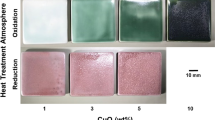Abstract
Infrared radiant powder was synthesized by conventional ceramic processing techniques by using Fe2O3, MnO2, CuO, Co2O3 and kaolin as raw materials. A novel infrared radiant glaze was developed by introducing the infrared radiant powder into glazing as a functional additive. Infrared radiant characteristics of the powder and the glaze were investigated. The optimum content of infrared radiant powder in glazing was ascertained to be 5%. The infrared radiant glaze exhibits significant antibacterial and antifungal functions due to the thermal effect of infrared radiation. Antibacterial percentages of the glaze reach 91%–100% when Escherichia coli, Staphylococcus aureus and Bacillus subtilis are used as model bacterium respectively, while antifungal percentage of the glaze exceeds 95% when Penicillum citrinum is used as model fungus.
Similar content being viewed by others
References
M Yashito and I Shigeo. Ag Containing Antibacterial Ceramic Products.Ceramics (in Japanese) 1996, 31(7):584–586
Ma Tiechang, Gao Wenyuan, Liu Guiwei and Cai Yingji. Study of Bactericidal Ceramic Glazed Tiles.Chinese Ceram. Soc. Bull. (in Chinese), 1999, 18(4):41–43
Liu Pin, Wang Xinchen and Fu Xianzhi. Processing and Properties of Photocatalytic Self-cleaning Ceramic.J. Inorg. Mater. (in Chinese), 2000, 15(1):88–92
Yu Jiaguo and Zhao Xiujian. Preparation and Microstructure of the Porous TiO2 Nanometer Thin Film by Sol—gel Method.J. Inorg. Mater. (in Chinese), 2000, 15(4):347–355
H Takashima, K Matsubara, Y Nishimura and E Kato. High Efficiency Infrared Radiant Using Transitional Element Oxide.J. Ceram. Soc. Jpn. (In Japanese), 1982, 90(7):373–379
Tu Pingliang, Chen Jiankang and Zhou Jianchu. High Emissivity Coating and Its Application for Energy—Saving.J. Infrared Millin. Waves (In Chinese), 1993, 12(6):436–440
Wu Wei, Wu Tao, Wu Yangfen and Zhao Ying. Design and Mechanism of Curing Diseases of Wide Band Therapeutic Instrument.J. Infrared Millim. Waves (In Chinese), 1997, 16(3):237–240
Zhang Xingxiang, Duan Jinyuan. The Health Care Function of Far-infrared Radiation Fabrics.Infrared Technology (in Chinese), 1994, 16(6):27–30
S Shoji. Test Method of Antibacterial Activity for Antibacterial Agents and Products.Ceramics (in Japanese), 1996, 31(7):590–593
Xu Qing, Chen Wen, Yuan Runzhang. Microstructure and Infrared Emissivity at Normal Temperature in Transitional Metal Oxides System Ceramics.J. Wuhan Univ. Tech.-Mater. Sci. Ed., 2000, 15(2):15–20
Lu Deyuan.Medical Microbiology. Beijing: People Health Press, 1998: 38–44
Author information
Authors and Affiliations
Additional information
XU Qing: Born in 1966; Ph. D.
Funded by the Foundation for Excellent Youth of Wuhan (No. 995004088G) and key Project of New Products of Hubei Province
Rights and permissions
About this article
Cite this article
Qing, X., Wen, C., Feng, Z. et al. A novel infrared radiant glaze exhibiting antibacterial and antifungal functions. J. Wuhan Univ. Technol.-Mat. Sci. Edit. 17, 10–13 (2002). https://doi.org/10.1007/BF02852624
Received:
Issue Date:
DOI: https://doi.org/10.1007/BF02852624




